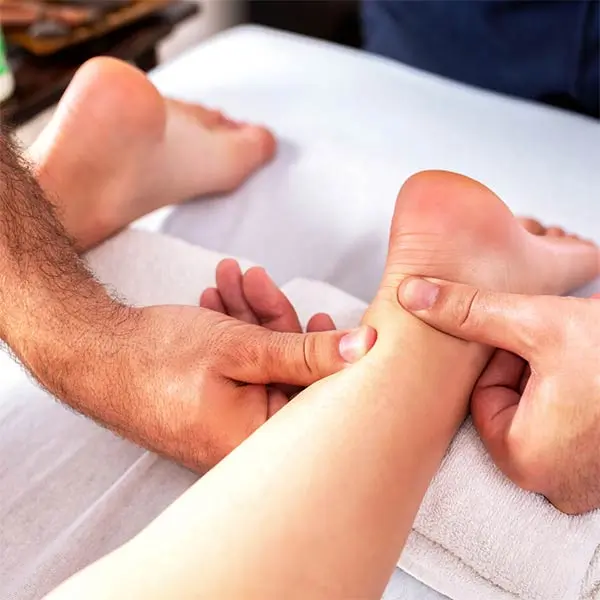Peroneal tendonitis is one of the most common injuries that runners face, but you don’t have to be an athlete to experience that nagging pain along the outer ankle. Even simple movements can be a challenge.
But did you know that movement can be part of the solution? While rest is important, the right combination of stretching and strengthening exercises can help ease discomfort, improve mobility, and get you back on your feet faster.
In this post, we’ll walk you through the best exercises for peroneal tendonitis recovery—helping you reduce pain, rebuild strength, and prevent future flare-ups.
What is Peroneal Tendonitis?
The peroneus longus and peroneus brevis tendons play an important role in stabilizing your ankle and supporting movement. Peroneal tendonitis occurs when the tendons connecting your ankle to the outside of your foot become inflamed and painful.
The peroneus longus, the longer of the two, runs beneath your foot and helps maintain your arch, while the peroneus brevis connects near your small toe. When working properly, these tendons allow for smooth, controlled movement. But when they become overworked or irritated, peroneal tendonitis can develop.
But, why do peroneal tendons become inflamed? There are a number of reasons, including:
· Overuse: Your tendons get stressed from activities like running, dancing, or sports that need quick direction changes
· Improper footwear: Shoes that don’t support your arch or fit poorly put extra strain on these tendons
· Foot structure: People with higher arches or specific foot alignment face more tension
· Muscle imbalances: Weak or tight lower leg muscles change how you move
· Previous ancle injuries: This includes injuries that didn’t heal properly
Signs & Symptoms Of Peroneal Tendonitis?
Foot and ankle pain does not always mean a peroneal tendonitis diagnosis. However ,a combination of the following signs and symptoms may indicate that your peroneal tendons are inflamed and require attention:
· Pain along the outer ankle that worsens with activity but improves with rest
· Swelling and tenderness behind or around the ankle bone
· A warm sensation over the affected tendon
· Instability or weakness in the ankle, especially on uneven surfaces
· Pain when pressing on the tendon or during certain movements
· Morning stiffness or discomfort that improves throughout the day
· A clicking or snapping sensation when moving the ankle, suggesting possible tendon displacement
RICE Treatment Method
The RICE method—Rest, Ice, Compression, and Elevation—is a simple and effective approach to managing peroneal tendonitis, helping to reduce pain, inflammation, and swelling in the early stages of recovery.
· Rest: Giving your foot a break is key to healing. Try to avoid activities that put stress on your ankle, like running or jumping. If your tendonitis is more severe, you might need a brace or even crutches to limit movement.
· Ice: A little ice goes a long way! Applying an ice pack for 15–20 minutes every few hours helps reduce swelling and pain. Always use a cloth or towel to protect your skin.
· Compression: Wearing an elastic bandage or ankle sleeve provides gentle support and controls swelling. Be sure to wrap snugly but not too tightly, as excessive pressure can restrict circulation.
· Elevation: Raising your foot above heart level, especially after activity, helps reduce swelling and promotes better circulation. Resting with your foot propped on pillows can aid in faster recovery.
The Importance of Exercise in Peroneal Tendonitis Recovery
While rest is important in the early stages of recovery, movement plays a crucial role in long-term healing. The right movements help improve tendon elasticity, strengthen surrounding muscles, and enhance range of motion, all of which contribute to pain relief and a lower risk of future injury.
· Increase blood flow to the injured area, delivering essential nutrients and removing inflammatory substances
· Support tendon repair by strengthening the muscles around the ankle
· Enhance mobility and flexibility, making the tendons more resilient to future strain
But knowing when and how to incorporate exercise is just as important as the exercises themselves.
Strengthening vs. Stretching: Why Both Matter
A balanced recovery plan includes both strengthening and stretching exercises. Strengthening exercises target the peroneal muscles, improving ankle stability and reducing excess strain on the tendons, whereas stretching exercises promote collagen production and improve the organization of muscle fibres, leading to stronger, more hardy tendons after recovery. Similarly, Balance training enhances proprioception (your body’s ability to sense movement and position), which reduces the risk of re-injury in the future.
When to Start Exercising After a Peroneal Tendonitis Diagnosis?
Rest comes first. In the initial phase of healing, limiting movement helps reduce inflammation. However, as pain subsides (usually after a few days), gentle stretching can begin to maintain mobility. Strengthening exercises should be introduced slowly and gradually to avoid overloading the tendons too soon.
Most people recover within 3-4 weeks using conservative treatment, but full rehabilitation can take 3-6 weeks, depending on the severity of the injury. But, always listen to your body—if an exercise causes sharp or worsening pain, stop immediately.
Precautions Before Starting Peroneal Tendonitis Exercises
Before jumping straight into exercises, taking the right precautions will protect yourself from further injury and keep your healing on track. A well-planned approach ensures that exercises do more good than harm.
· Get Medical Clearance First: Before starting any new exercise program for peroneal tendonitis, consulting a medical professional will assess your condition and guide you through exercises that build ankle strength, improve flexibility, and support tendon healing while also teaching proper techniques and suggesting modifications to prevent re-injury.
· Warm Up & Cool Down: Jumping straight into exercise without preparation can increase your risk of strain. A 5-10 minute warm-up helps get blood flowing to your tendons and prepares your ankle for movement. Gentle activities like walking, stationary cycling, or slow ankle circles can help loosen up the area before starting your exercises. After your workout, a proper cool-down routine can reduce stiffness and inflammation, helping you recover faster.
· Wear the Right Footwear & Orthotic Support: Your choice of footwear also plays a huge role in tendon health. To reduce strain on your peroneal tendons, it’s important to wear shoes with good arch support and cushioning. Avoid flexible soles, flat shoes, and unsupportive footwear. Taking breaks from walking barefoot can also help, as unsupported feet can worsen pain and delay healing. Orthotic inserts are another useful tool, as they help offload pressure from your peroneal tendons. Additionally, if your ankle feels unstable, wearing an ankle brace can provide extra support, especially during movements that involve side-to-side motion.
Stretching Exercises for Peroneal Tendonitis Relief
Stretching plays a key role in peroneal tendonitis recovery by improving flexibility, reducing strain, and supporting the healing process. Gentle, consistent stretching helps maintain ankle mobility without straining the surrounding muscles and tendons.
Calf Stretches
The flexibility of your calf muscles directly affects the health of your peroneal tendons. A simple wall stretch can help loosen tight calves and relieve tension on the ankle.
- Step 1: Stand facing a wall with your hands placed at shoulder height for balance.
- Step 2: Step the affected leg behind you, keeping your heel firmly planted on the ground.
- Step 3: Gently bend your front knee while keeping the back leg straight, feeling a stretch along your calf.
- Step 4: Hold this position for 30-60 seconds.
- Step 5: Repeat the stretch three times. Perform this stretch two to three times daily.
Tip: For a deeper stretch, try the soleus stretch where you sightly bend your back knee while maintaining both heels on the ground.
Towel and Hamstring Stretches
Your peroneal tendons don’t work in isolation—tension in the surrounding muscles can also contribute to discomfort. These stretches target the tissue chains that support your peroneal tendons, improving flexibility and aiding in recovery..
- Step 1: Sit with your legs extended straight out in front of you.
- Step 2: Loop a towel around the toes of the affected leg.
- Step 3: Gently pull the towel towards your body until you feel a stretch along the foot arch and calf.
- Step 4: Hold the stretch for 30 seconds.
- Step 5: Repeat this stretch three times. Perform this stretch daily for best results.
Ankle Mobility Exercises
Improving ankle range of motion helps decrease stress on the peroneal tendons. Simple ankle mobility exercises can make a big difference.
Ankle Circles:
- Step 1: Sit comfortably with your leg elevated.
- Step 2: Rotate your foot clockwise in a circular motion for 10 repetitions.
- Step 3: Afterward, rotate your foot counterclockwise for another 10 repetitions.
Ankle Flexion:
- Step 1: Sit with your legs extended out in front of you.
- Step 2: Gently point your toes away from your body.
- Step 3: Pull your toes back towards your body.
- Step 4: Repeat the motion 10 times, ensuring slow and controlled movements.
Foot and Plantar Fascia Stretches
Since the peroneal tendons work closely with other foot structures, targeted foot stretches can help ease discomfort as well.
Cross-Legged Ankle Stretch:
- Step 1: Sit with one ankle crossed over the opposite thigh.
- Step 2: Gently tilt the sole of the foot towards the floor.
- Step 3: Hold for 30 seconds.
Golf Ball Roll:
- Step 1: While seated, place a golf ball under the arch of your foot.
- Step 2: Roll the ball back and forth for 1-2 minutes, applying light pressure to release tension.
Strengthening Exercises for Peroneal Tendonitis Recovery
By strengthening the muscles surrounding the tendons, you can restore function, reduce pain, and help prevent future injuries. Incorporating targeted exercises into your routine helps rebuild muscle power, providing better support to your ankle and speeding up recovery.
Resistance Band Exercises
Resistance band exercises specifically target the peroneal muscles, which run along the outer side of the lower leg and are responsible for stabilizing the ankle and supporting lateral movements. Weakness in these muscles can lead to instability and increased stress on the tendons, making everyday movements—such as walking and running—more uncomfortable and painful. By strengthening them, you can improve ankle control and reduce the risk of re-injury.
Ankle Eversion
- Step 1: Sit with your legs extended in front of you.
- Step 2: Loop a resistance band around the top of your foot, anchoring the other end to a sturdy object or your opposite foot.
- Step 3: Slowly turn your foot outward, away from your midline, against the resistance of the band while keeping your heel in contact with the floor.
- Step 4: Hold the position for about 5 seconds before slowly returning to the starting position.
- Step 5: Repeat for 10-15 repetitions, gradually increasing resistance as your strength improves.
Resisted Ankle Dorsiflexion
- Step 1: Sit with your legs extended and loop a resistance band around your forefoot, securing the other end.
- Step 2: Point your toes downward toward the floor.
- Step 3: Slowly pull them back up toward your shin, working against the resistance of the band.
- Step 4: Repeat for 10 controlled repetitions, ensuring smooth and controlled movements.
Calf and Heel Strengthening Exercises
Strong calf muscles are essential for absorbing impact forces when walking, running, or jumping. When your calves are weak, the peroneal tendons take on more stress, which can worsen tendonitis. Strengthening the calves ensures that the workload is distributed more evenly across the lower leg, reducing strain and discomfort.
Single-Leg Heel Raises
- Step 1: Stand behind a chair or countertop for support.
- Step 2: Lift your unaffected foot off the ground so that all your weight is supported by the injured foot.
- Step 3: Slowly raise your heel as high as possible while keeping your balance.
- Step 4: Lower your heel back down in a controlled manner.
- Step 5: Perform 10-15 repetitions, increasing as you get stronger.
Balance and Stability Training
One of the main issues caused by peroneal tendonitis is reduced ankle stability. The peroneal muscles help control lateral movement and prevent the ankle from rolling outward. When these muscles are weakened due to injury, your ankle may feel wobbly or unsteady, increasing the risk of sprains or falls.
Additionally, peroneal tendonitis can impair proprioception—your body’s ability to detect movement and adjust accordingly. This means that if your ankle is in a vulnerable position, your body may not recognise it quickly enough to prevent an injury.
Muscle response time is another key factor in ankle stability. Normally, strong and healthy muscles engage quickly to stabilize the ankle when you step on an uneven surface. However, when injured they react more slowly and you are more likely to develop compensatory movement patterns, putting more strain on your hips and knees.
Single-Leg Standing
- Step 1: Stand on your affected foot and hold the position for 30 seconds.
- Step 2: If this becomes easy, progress by standing on an unstable surface, such as a foam pad or pillow.
- Step 3: Repeat for 3-5 rounds.
Lateral Leg Raises
- Step 1: Stand on one foot and keep your core engaged.
- Step 2: Slowly lift the opposite leg sideways while maintaining a straight posture.
- Step 3: Lower the leg back down with control.
- Step 4: Repeat for 10 repetitions on each leg.
Training Tips
As you progress you can consider adding some additional challenges to ensure you continue to progress. These can include:
· Extend the duration from 30 seconds to 1-2 minutes
· Work without visual input (eyes closed)
· Add movement challenges like arm motions or head turns
· Practise on unstable surfaces (only if you are comfortable!)
Key Considerations for Exercises
· Start Slow and Progress Gradually: Begin with gentle movements and slowly increase intensity. Rushing can strain your tendons and delay healing. Build strength and stability step by step.
· Avoid Pain: Listen to your body to prevent setbacks. Mild discomfort is normal, but sharp pain is a red flag. Stop any exercise that causes pain and modify as needed.
· Be Consistent: Regular exercise is essential for recovery. Aim for 3–5 sessions per week to steadily improve strength, flexibility, and stability.
· Allow for Rest and Recovery: Balance activity with rest to prevent overuse injuries. Recovery days give your tendons time to heal, keeping your progress on track.
Key Takeaways
Recovering from peroneal tendonitis takes patience, consistency, and a structured approach. With the right balance of rest, gentle movement, and targeted exercises, most people see significant improvement within a few weeks.
But true recovery doesn’t stop when the pain disappears. Ongoing ankle care and smart prevention strategies, like supportive footwear, maintaining flexibility, and incorporating strengthening exercises into your routine can help keep your tendons healthy.
At Coastal Podiatry Foot & Ankle Clinic, we are proud to offer the highest standard of podiatric care. Whether you’re dealing with persistent tendon issues or just want to future-proof your ankle health, we’re here to help the Sunshine Coast community move with confidence.
Need guidance? Get in touch with Coastal Podiatry today!




